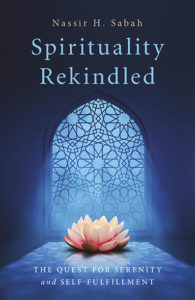(Original article: Mystic Living Today, March 2024)
Nassir H. Sabah
Our species, Homo sapiens, has three formidable characteristics: (i) astonishing mental capacities, including advanced cognitive skills, imagination, abstract thinking, and a mysterious consciousness, (ii) a highly developed language, and (iii) exquisite manual dexterity. It is generally believed that these characteristics were acquired rather suddenly between 70,000 and 30,000 years ago in what is referred to as the “cognitive revolution”, or the “great leap forward” (not to be confused with Mao Zedong’s great leap forward).
As a result, some very useful implements were invented such as: bows and arrows, oil lamps, fishhooks and harpoons, bone and ivory needles for stitching clothing together, and boats to venture into the open waters. Through planning, cunning, social skills, productive labor, and creative thinking, Homo sapiens prevailed, within a relatively short span, over all other human and animal species to become the masters of planet Earth.
These characteristics are underpinned by appropriate developments in the brain and the rest of the neuromuscular system. The cerebral cortex, responsible for our higher mental functions, acquired some 16 billion nerve cells that are more numerous, more developed and varied, with more complex interconnections, than in any other species.
The human brain has two language areas, Broca’s area involved in speech production and Wernicke’s area involved in the comprehension of written and spoken language. These areas are in the dominant cerebral hemisphere, which is more analytic than the non-dominant hemisphere and is specialized for conceptualization, temporal analysis rather than spatial synthesis, perceiving details rather than form, and coding sensory input in terms of linguistic expressions rather than images. The relation between language and higher mental functions is quite intriguing.
The unsurpassed manual dexterity of humans is supported not only by the ability to move the thumb opposite the fingers but also by the relatively large areas of the brain involved in fine, coordinated movement of the fingers and in the exquisite sense of touch, particularly in the forefinger. Human manual dexterity not only enabled the making of tools and artifacts, but more importantly perhaps, allowed writing, as this is essential for preserving and transmitting cultures and other elements of civilization.
It is my personal belief that the “creation” of humans refers to the endowment of Homo sapiens with the aforementioned human characteristics, and not to the common understanding of the story of Adam and Eve. Is this compatible with the narrative of the creation of Adam and Eve in the Bible and the Quran? I believe it is compatible with the Quran. Even some early commentators of the Quran understood the story of Adam to be allegorical; “Adam” could be the name of an individual but could also stand for humankind.
Verse 30, Chapter 2, of the Quran states: “And when thy Lord said to the angels, ‘I am placing an agent-inheritor (referring to Adam) upon the Earth,’ they said, ‘Wilt Thou place therein one who will work corruption therein, and shed blood, while we glorify Your praise and proclaim Your holiness’ He said, ‘Truly I know what you know not.’”
The Quran refers elsewhere to humankind, in the plural, as being His agents-inheritors (Q6:165). Angels do not know the future. Their mention of “one who will work corruption and shed blood” can be understood to refer to beings already in existence and who, as agents-inheritors of the Earth, will continue to corrupt and shed blood.
The succeeding verse (Q2:31), “And He Taught Adam all the names…”, has been interpreted to mean that Adam was taught all the languages of the earth, that is, humans were endowed with a well-developed faculty of language.
Verses 4-5, Chapter 96, “Who (God) taught by the pen, taught man what he knew not”, refers to the acquisition of knowledge through writing. This is an explicit reference to the human ability to write and to learn from what has been preserved through writing.
Verses 3-4, Chapter 55, of the Quran, “He created man, taught him al-bayan”, link creation of man to his being taught al-bayan, where this Arabic word translates as the ability to express and articulate feelings and thoughts. This implies advanced mental activities whose articulation requires a well-developed language.
Conclusion
The “creation” of humans is the endowment of beings who already existed, after having evolved over so many years, with some advanced characteristics.
It is worth noting that the story of Adam in the Quran differs in several respects from that in the Bible. Eve is not mentioned by name, only as Adam’s wife (the only female mentioned by name in the Quran is Maryam, the Virgin Mary). There is no mention of Adam’s wife being created from his rib; all humans are created from the same “self”. Satan tempted both Adam and his wife to eat from the “forbidden” tree, which he described to them as “the tree of immortality and a kingdom that never decays”. There is no mention of the kind of fruit of this tree, nor of original sin.
As to why God Almighty endowed humans with these astounding characteristics, it is to receive His revelations, bear witness, through contemplation and scientific discovery, to His manifestations in the marvels of His creation, and to serve Him, as His agents-inheritors, by reflecting through our daily conduct, what can be humanly reflected from His glorious and perfect attributes. This means virtuous conduct towards all around us: other human beings, other forms of life, and the environment.
